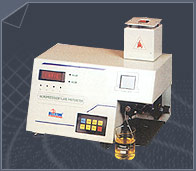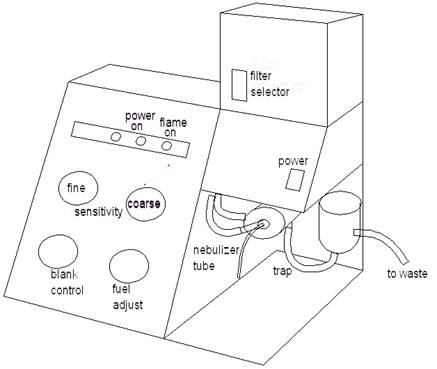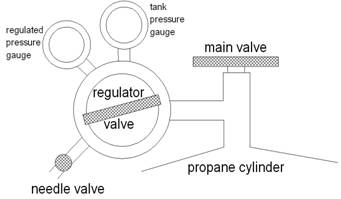
CHM3120L
Introduction to Analytical Chemistry: Laboratory
| Lab Schedule |
| LON-CAPA Pre-Labs |
| Resources |
| Contact Instructor |
| Chemistry Home Page |
![]()
Li by Flame Emmision: Procedure
Instrument Familiarization.
The instrument is a filter photometer equipped with filters for Na, Li and K. It uses a propane/air flame.

Identify the burner with its nebulizer tube for aspirating sample and waste drain tube. The trap tube between the burner and waste overflow container should be filled with water. Is it? Do not operate the burner without water in the tube. If the tube is not filled with water the propane/air mix will escape into the room.
Locate the filter selector on the chimney and set it for Li.
On the front panel of the instrument identify the power switch, the fuel adjustment control, the blank control, the coarse and fine sensitivity controls, the “power on” indicator light, and the “flame on” indicator light.

The TA will demonstrate the procedure for operating the burner. These are the steps:
- Switch on the air compressor. Check the pressure on the left gauge. If it is not set at 20 psi, then adjust the left valve to obtain a reading of 20 psi.
- Open the main valve (turn it counterclockwise) on the top of the propane cylinder. Open the needle valve on the regulator. Adjust the regulator pressure to 30 psi (clockwise adjustment increases the pressure). Do not adjust the front panel fuel adjustment control. It should already be at the correct position (about 9 turns counterclockwise from the fully closed position).
- Turn on the main power switch. The power indicator light should come on. You should be able to hear the piezoelectric igniter firing, and after a few seconds the flame indicator light should come on. If the flame does not start, shut off the fuel at the main valve (fully clockwise) on the propane cylinder. The regulator gauge should read zero. Have the TA check your procedure and attempt to start the burner.
- Insert the nebulizer tube in a beaker containing 100 mL or more of sodium free water and allow the system to operate for 15 minutes to stabilize the temperature. You can prepare solutions during this time.
Preparation of Solutions. Give your lab instructor a clean, 100 mL volumetric flask, into which he/she will put your unknown. Be sure that this flask, and all other glassware used in this experiment, is carefully rinsed with distilled water.
Dilute to the mark with deionized water in the 100 mL flask containing your unknown sample.
The Li stock solution provided has a concentration of about 200 mg/L. Record the exact concentration given on the label.
Using a transfer pipet, transfer 25 mL of the Li stock solution to a 50 mL volumetric flask and dilute to volume with the distilled water.
Obtain additional 50 mL flasks to prepare five standard solutions and one diluted unknown solution. Label the flasks 1, 2, 3, 4, 5 and x. With a Mohr pipet dispense diluted Li stock solution into the flasks as follows: 1 mL into flask #1, 2 mL into flask #2, 3 mL into flask #3, 4 mL into flask #4 and 5 mL into flask #5. Transfer 5 mL of your unknown solution to the last flask. Dilute all flasks to volume with distilled water and calculate the Li concentration in the standards.
Measurements. Alternate spraying your solutions with spraying distilled water as a blank. The difference between the signal obtained when spraying a sample solution and that obtained when spraying the distilled water is the background corrected reading. Each time you change solutions you should wait about 20 seconds for the signal to stabilize before recording a reading.
- While spraying the blank (deionized water), adjust the blank control for a reading near zero.
- Aspirate the highest concentration standard. Adjust the sensitivity controls so that a convenient on-scale reading is obtained. Do not change adjust the sensitivity control for any of your subsequent readings.
- Record background corrected Li reading for each of your standard and unknown solutions.
- Check that your unknown gives a reading that falls in the linear portion of the calibration curve. If it does not, adjust its dilution and repeat the measurement.
- Record background corrected Li readings for each of your standard and unknown solutions two more times.
Shut down the instrument:
- Aspirate deionized water for 60 seconds to flush the burner assembly.
- Shut off the fuel (clockwise turns) at the main cylinder valve.
- Turn the regulator control counterclockwise to release pressure on the diaphragm.
- Close the needle valve on the regulator.
- Turn off the air compressor.
- Turn off the main power switch.